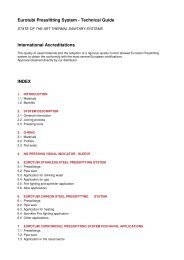corrosion of stainless steel - Damstahl
corrosion of stainless steel - Damstahl
corrosion of stainless steel - Damstahl
Create successful ePaper yourself
Turn your PDF publications into a flip-book with our unique Google optimized e-Paper software.
Chapter 6 - Corrosion <strong>of</strong> Stainless Steel<br />
General<br />
<strong>corrosion</strong> in<br />
molten salts<br />
In addition to aqueous media, general <strong>corrosion</strong> is a risk if the <strong>stainless</strong><br />
<strong>steel</strong> is exposed to molten salts. Just as in strong acids, liquid, chloride and<br />
fluoride salts (e.g. fluxes for soldering, temperatures typically > 400°C) may<br />
entail total breakdown <strong>of</strong> the protective oxide layer <strong>of</strong> the <strong>stainless</strong> <strong>steel</strong><br />
which will result in rapid general <strong>corrosion</strong>. General <strong>corrosion</strong> in alkaline<br />
media or molten salts is, however, rare. Below the emphasis will therefore<br />
be on the strong, aqueous acids. A typical example <strong>of</strong> general <strong>corrosion</strong> <strong>of</strong><br />
<strong>stainless</strong> <strong>steel</strong> in molten salts can be found in Figure 6.6.<br />
Even in strong acids, <strong>stainless</strong> <strong>steel</strong> can achieve a certain level <strong>of</strong> passivity,<br />
and in practice there is a big difference between an acid that simply thins<br />
the passive layer, but does not entirely dissolve it, and an acid that eats away<br />
the whole <strong>of</strong> the passive layer and immediately attacks the underlying <strong>steel</strong>.<br />
Relatively weak and pure acids (e.g. citric acid, acetic acid or formic acid)<br />
only thin the naturally occurring oxide layer slightly. The oxide layer is<br />
restored with the same speed, and <strong>corrosion</strong> loss is minimal - at least when<br />
the acids are pure. If the acids contain aggressive ions (especially chloride),<br />
the situation may become far worse, especially at high temperatures.<br />
Iso<strong>corrosion</strong><br />
diagrams<br />
indicate<br />
combinations<br />
<strong>of</strong> metals and<br />
environments<br />
with the same<br />
<strong>corrosion</strong> rate<br />
6.1.1 Iso<strong>corrosion</strong> Diagrams<br />
The corrosivity <strong>of</strong> a certain acid towards various types <strong>of</strong> <strong>stainless</strong> <strong>steel</strong> can<br />
be read on a so-called iso<strong>corrosion</strong> diagram. An iso<strong>corrosion</strong> diagram is a set<br />
<strong>of</strong> curves showing the acid concentration on the x axis and the temperature<br />
on the y axis. Each curve shows the conditions that are required to peel <strong>of</strong>f<br />
precisely 0.1 mm <strong>of</strong> <strong>steel</strong> per year. Above the curve, conditions are more<br />
corrosive than 0.1 mm/year, while under the curve conditions are milder.<br />
An example <strong>of</strong> an iso<strong>corrosion</strong> diagram for different types <strong>of</strong> <strong>stainless</strong> <strong>steel</strong><br />
in sulphuric acid can be found in Figure 6.3.<br />
The <strong>corrosion</strong> rate for a given combination <strong>of</strong> <strong>stainless</strong> <strong>steel</strong>, acid and<br />
temperature can be determined by simple weight loss experiments. All you<br />
need is a sheet with a known area and known weight, and after a certain<br />
length <strong>of</strong> time in the acid the sheet is weighed again - the amount <strong>of</strong> metal<br />
that has corroded away can then be calculated. This technique can only<br />
be used for <strong>corrosion</strong> experiments where the loss <strong>of</strong> material is entirely or<br />
almost entirely homogenous - such as general <strong>corrosion</strong>. For all other types<br />
<strong>of</strong> <strong>corrosion</strong>, the weight loss technique will, at best, be an imprecise way <strong>of</strong><br />
measuring <strong>corrosion</strong>.<br />
75<br />
RS for alle.indb 75<br />
9/29/2011 12:44:32 PM

















